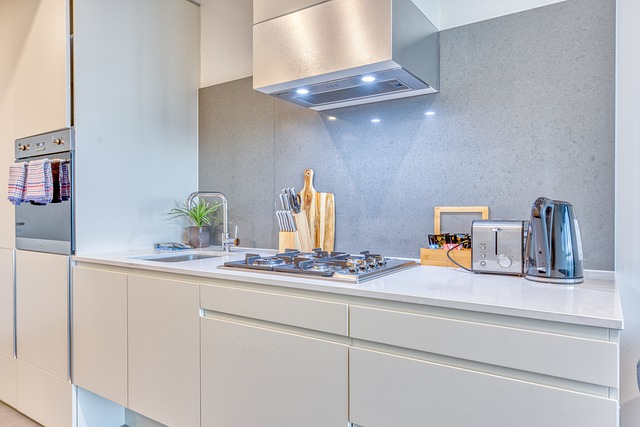A kitchen remodel focused on energy efficiency offers both environmental and economic benefits. By incorporating eco-friendly upgrades like ENERGY STAR-rated appliances, low-energy LED lighting, improved insulation, and sustainable materials, you reduce your carbon footprint, decrease utility bills, and create a healthier living space. These changes contribute to sustainable kitchen renovation by minimizing electricity consumption and water waste. Key elements include energy-efficient appliances, smart lighting controls, and efficient ventilation, making it a smart investment for both the environment and your wallet.
Transforming your kitchen into an energy-efficient oasis isn’t just about aesthetics; it’s a smart way to reduce utility bills and cut down on your carbon footprint. This article explores the multifaceted benefits of incorporating eco-friendly elements in your kitchen remodel. From understanding the impact of energy efficiency to discovering innovative design strategies, we’ll guide you through essential steps. Learn how to choose sustainable appliances, adopt low-energy lighting solutions, and implement cost-effective green renovations for a more environmentally conscious cooking space.
Understanding Energy Efficiency in Kitchens: Benefits and Impact
Understanding Energy Efficiency in Kitchens: Benefits and Impact
A kitchen remodel focused on energy efficiency isn’t just an eco-friendly choice; it’s a smart investment. By incorporating energy-efficient kitchen design elements, you’re making your home more sustainable while potentially lowering utility bills. Eco-friendly kitchen upgrades like energy-saving kitchen appliances, low-energy lighting for kitchens, and improved insulation can significantly reduce your carbon footprint—and save you money in the long run. Sustainable kitchen renovation offers a range of benefits, from decreasing electricity consumption to minimizing water waste.
These changes not only help preserve our environment but also create a healthier living space. Modern energy-efficient kitchen appliances are designed with advanced technology, ensuring better performance while using less power. Low-energy lighting options, such as LED bulbs, provide bright illumination without the high energy costs. Additionally, these upgrades can enhance your kitchen’s overall aesthetics and functionality, creating a more appealing and efficient cooking environment.
Essential Elements of an Energy-Efficient Kitchen Design
When planning a kitchen remodel with an eye towards sustainability and cost savings, incorporating energy-efficient design elements is a smart move. An eco-friendly kitchen upgrade doesn’t just benefit your wallet in the long run; it also reduces your carbon footprint, making it a responsible choice for environmentally conscious folks.
Key components of this transition include selecting energy-saving kitchen appliances, opting for low-energy lighting solutions like LED fixtures, and choosing materials with sustainable credentials. Additionally, smart designs that promote natural ventilation and proper insulation can significantly cut down on energy usage. A sustainable kitchen renovation isn’t just about the initial installation; it’s a long-term commitment to responsible living, ensuring your kitchen operates efficiently while minimizing its environmental impact.
Choosing Eco-Friendly Appliances: A Guide to Sustainable Upgrades
When planning a kitchen remodel with an eye toward sustainability and energy efficiency, selecting eco-friendly appliances is a strategic step. These appliances are designed to consume less energy, thereby reducing utility bills and your carbon footprint. Look for models bearing energy-efficiency ratings and certifications like ENERGY STAR, which guarantee significant power savings compared to standard alternatives. For instance, opt for energy-saving refrigerators with smart features that adjust temperature settings automatically, or choose induction cooktops that are 70% more efficient than gas stoves.
Consider also the potential of low-energy lighting solutions such as LED bulbs, which use up to 85% less electricity than incandescent bulbs and last much longer. Integrating these upgrades into your kitchen remodel not only contributes to environmental conservation but also offers long-term financial benefits through reduced energy consumption.
Illuminating the Way: Low-Energy Lighting Solutions for Kitchens
When planning a kitchen remodel focused on energy efficiency, illuminating the space with eco-friendly lighting solutions is paramount. Traditional incandescent bulbs guzzle energy and contribute to higher utility bills and increased carbon emissions. Fortunately, modern low-energy lighting options for kitchens offer both style and sustainability. LED (Light Emitting Diode) fixtures have become industry standards due to their longevity, versatility, and minimal power consumption. They come in various designs, from sleek undercabinet lights that enhance food preparation tasks to elegant pendent lamps that double as decorative accents.
Integrating smart lighting controls further streamlines energy savings. Motion sensors or timers ensure lights automatically turn off when not in use, minimizing waste. Dimmers allow you to adjust brightness according to task requirements, reducing energy usage without compromising ambiance. These eco-friendly kitchen lighting solutions contribute significantly to a sustainable kitchen renovation, slashing energy costs and your carbon footprint while enhancing the overall aesthetic appeal of your space.
Simple Yet Effective Tips for Green Kitchen Renovation on a Budget
A green kitchen remodel doesn’t have to break the bank. There are plenty of simple yet effective tips to create an energy-efficient and eco-friendly space without overspending. Start with basic upgrades like switching to energy-saving LED lights, which use up to 80% less energy than traditional bulbs and last much longer. Replacing old appliances with ENERGY STAR-rated models can also significantly reduce your kitchen’s carbon footprint. Consider a simple paint job or new countertops to give your space a fresh look without the high cost of major renovations.
Incorporate sustainable materials where possible, such as recycled countertops or flooring. Opting for locally sourced and second-hand fixtures and fittings not only reduces transportation emissions but can also be more affordable. Don’t overlook the power of smart storage solutions, like adding under-cabinet lighting to reduce energy waste and improve efficiency in your cooking and meal prep. Lastly, consider a water-saving faucet or low-flow showerhead in your kitchen sink to further cut down on resource consumption.
A kitchen remodel offers a fantastic opportunity to embrace energy efficiency and reduce your environmental impact. By incorporating smart design elements, choosing eco-friendly appliances, and opting for innovative low-energy lighting solutions, you can create a sustainable kitchen that saves money and minimizes your carbon footprint. With these ideas and tips, you’re well on your way to a greener future, one meal at a time.
